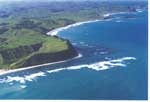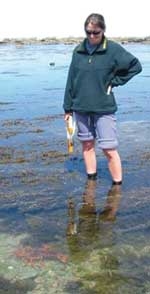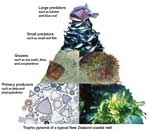PDF of this article (187 KB)





Coastal managers face a balancing act when it comes to competing demands for marine resources. Carolyn Lundquist, Matt Pinkerton, Debbie Freeman, and Clinton Duffy explain how trophic models can help find the balance.
Setting aside specific areas for particular types of activity can be a useful way to manage human effects on marine ecosystems. For example, some areas might allow commercial fishing, while others are reserved solely for recreational or customary fishing; yet others may allow no fishing, such as designated no-take marine reserves. These different types of management can result in different abundances – or numbers – of the plants and animals found within each area, particularly those taken in fisheries. For example, we would expect to see lower numbers (and often smaller sizes) of many top predators like snapper, blue cod, and lobster (crayfish) in fished areas compared to neighbouring areas that are no-take reserves. We often see other changes in marine communities, for example, in the numbers of prey species of large predators, or in abundance of algal communities when grazer populations change: in some marine protected areas kelp forests spread when grazing kina (urchin) decrease, which is due in turn to increased predation on kina by larger and more abundant lobster and snapper. This effect is called a ‘trophic cascade’, where changes in one level in a trophic pyramid (in this case, lobster, blue cod, and snapper) result in ‘cascading’ effects through other levels (for example, kina and kelp).
Ecological effects of marine resource management
Trophic interactions are usually complex, and it’s difficult to predict how one species will respond to higher (or lower) numbers of other species. While trophic effects like the lobster–kina–kelp example have been studied extensively, the effects of different types of marine management on other marine organisms are not so well known. For example, increased predator abundance might decrease the abundance of other animals (such as mussels or small fish) that might be preferentially eaten by the large predator. Lobsters and fish eat more than just kina, ranging from sponges and other encrusting animals to mobile animals like crabs, sea snails, and fish. To gain a better understanding of the interactions among all parts of an ecosystem, we must develop a food web linking all groups from primary producers like phytoplankton and algae, to grazers like kina and paua (abalone), to predators like fish and seabirds.
Trophic modelling
There are modelling tools that can help us to better understand and predict ecosystem-level effects of marine resource management. Trophic models describe energy flow between the different species or trophic groups in an ecosystem. The model links each group through its abundance and the proportion of species in other trophic groups that it eats. The lowest level includes primary producers (marine plants like algae and phytoplankton), which produce organic matter using photosynthesis. This organic matter is transferred to higher trophic levels when the primary producers are consumed by zooplankton and grazing animals, which are then consumed by higher groups like fish, lobster, and seabirds. With this approach, we can model how each trophic group will be affected if we change the abundance of one or many species. The model can be used to investigate different fishing, aquaculture, and conservation strategies. Thus far, most trophic models in New Zealand have concentrated on large oceanic ecosystems (for example, the Southern Plateau and the Chatham Rise – see Water & Atmosphere 10(4): 16–17 and 12(2): 22–23). Here we examine a coastal region, looking at how different management strategies may alter marine community structure.
A case study
We modelled Ngāti Konohi Rohe Moana, a coastal region near Gisborne which includes a 2452-ha no-take marine protected area (Te Tapuwae o Rongokako Marine Reserve), areas open to both commercial and recreational fisheries, and an area that is currently proposed by Ngāti Konohi as a mataitai reserve. The region is monitored regularly to determine abundance of lobster, paua, kina, and reef fish, and there are maps of the different habitat types. The region includes a range of rocky-reef and soft-sediment intertidal and subtidal habitats, with extensive intertidal reef platforms. These reef platforms support grazing invertebrates like kina, paua, pūpū (sea snails), and ngākihi (limpets), and algae that are important for customary and recreational fisheries. Monitoring has shown that the number of lobster in the reserve has increased substantially since 1999 when the reserve was gazetted.
One ecological question we want to ask is: ‘How does this increase in lobster abundance affect community structure?’ Lobsters consume many invertebrate species, both on intertidal reef platforms and subtidal reefs, and also in soft-sediment areas adjacent to reefs. An increase in their numbers could affect many other species in the marine community. We are also interested in predicting potential changes due to fishing of other species, including those taken in customary and recreational fisheries, and how we might expect the ecological effects from commercial, recreational, and customary fisheries to interact across management boundaries.
Implications for marine management
Our model has been valuable in demonstrating the major trophic groups that contribute to the dynamics of this coastal food web. For example, we determined that primary production in the region is dominated (over 40%) by canopy-forming macroalgae such as large kelps, but also includes significant contributions from phytoplankton, from algae living within the sediment, and from smaller leafy and crustose macroalgae. These are consumed primarily by invertebrates; the most numerous consumer groups are encrusting animals like sponges, zooplankton, phytal invertebrates (small animals living on algae), and lobster.
We used these baseline estimates of abundance of each trophic group to predict the implications of different management strategies. Model estimates are also valuable in demonstrating which trophic groups we know the least about, particularly relative to their importance in the model. For example, we have very good estimates of paua, kina, lobster, and reef fish in the region, but don’t know much about other groups that they feed on, such as phytal and encrusting invertebrates.Our future research lies in increasing our modelling capability and collecting more data on many lesser known trophic groups to improve the predictive ability of our trophic model. This will help us to better understand the links between different trophic groups in this coastal marine ecosystem, and to better use trophic models in coastal management in New Zealand.
Some food web terms
Primary producers – organisms that produce organic matter using photosynthesis. Marine examples include algae (kelp) and phytoplankton. Consumers – organisms that are not primary producers, but instead eat primary producers or other animals. Grazers / Herbivores – organisms that eat primary producers. Marine examples include kina, paua, and butterfish. Predators / Carnivores – organisms that eat other consumers. Marine examples include lobster, blue cod, and snapper. Trophic model – a model that connects all the species in an ecosystem through their feeding relationships. Trophic group – a group in the model that may be comprised of a single species (such as lobster) or multiple species (such as grazing invertebrates) that have similar diets and interactions with other species groups.
Striking a balance
- Marine resource managers have a suite of options for how they designate coastal uses.
- Trophic models illustrate complex predator–prey relationships within an ecosystem.
- They can help managers select the best mix of reserves and fishing areas.
Dr Carolyn Lundquist is a marine ecologist at NIWA in Hamilton and Dr Matt Pinkerton is based at NIWA in Wellington, where he works on ecosystem and trophic modelling and remote sensing. Debbie Freeman is a marine ecologist at the Department of Conservation (DOC) in Gisborne, and is responsible for the monitoring programme at Te Tapuwae o Rongokako Marine Reserve. Clinton Duffy is a marine ecologist with DOC’s Marine Conservation Unit in Auckland.
This work was funded jointly by DOC’s MoRST project: ‘Maori Methods and Indicators of Marine Protection’, and by several of NIWA’s FRST research programmes: ‘Ocean Ecosystems: their Contribution to New Zealand Marine Productivity’; ‘Sustainability and and Enhancement of Coastal Reef Fisheries of Economic and Cultural Importance’; ‘Ecosystem-based Management of New Zealand’s Coastal and Oceanic Waters’; and a Capability Fund project: ‘Trophic Modelling of Ecosystem Dynamics’.
Teachers’ resource for NCEA Achievement Standards or Unit Standards: Biology Level 1 US6299, Level 2 AS90461, AS90769, US6309, US6312, Level 4 US9226 Science Level 3 US8153 See other curriculum connections at www.niwa.co.nz/pubs/wa/resources
